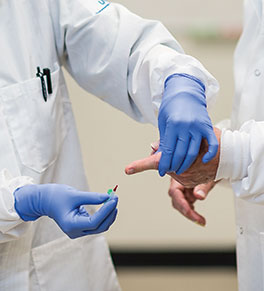Understanding a virus
UCI biophysicist Philip Felgner’s research aims to protect us from COVID-19.

Blood samples taken with a simple prick of the finger from people throughout Orange County were tested by leading virologist Philip Felger, PhD, and his team at the UCI Vaccine Research and Development Center. Photo by Michael Der
As the world continues to struggle with the novel coronavirus pandemic, the work of UCI biophysicist Philip Felgner, PhD, and others has never been more critical.
A professor of biophysics and physiology at the UCI School of Medicine, Felgner is a renowned expert on vaccines, infectious diseases and adaptive immunity. Earlier in his career, his landmark discovery led to the development of a new class of vaccines referred to as DNA vaccines and "lipofection" DNA transfection technology, the most widely used approach for introducing nucleic acid into cultured cells.
Today, Felgner directs the UCI Vaccine Research and Development Center and the Protein Microarray Laboratory and Training Facility, where he and his team are testing the antibody response of people who have been exposed to the virus. The antibody studies have shed light on the spread of the virus among UCI healthcare professionals, one group his team has tested, as well as large segments of the Orange County public.
In a Q&A with Live Well, Felgner explains what we know and are trying to understand about the virus, formally named SARS-CoV-2.
How do antibodies protect against future infection?
When a person is exposed to SARS-CoV-2 — the virus that causes COVID-19 — the body’s immune system creates antibodies to it. The next time a person is exposed to the virus, those antibodies bind to the virus and help eliminate it from the body.
You’ve developed a new test for detecting antibodies to SARS-CoV-2 and other respiratory viruses. How does it work?
Our COVID-19 Coronavirus Antigen Microarray Technology tests for the presence of antibodies to SARS-CoV-2, other coronaviruses as well as different viruses that cause respiratory infections.
Blood from a finger stick is tested and results are available in a few days.
What can you learn by analyzing different groups of people for SARS-CoV-2 antibodies?
We’re looking not just at exposure to SARS-CoV-2, but also to other respiratory viruses that cause flu-like symptoms.
A person’s past exposure to different types of viruses and disease proteins may lead to different responses to this virus. It could account for why older people are more susceptible to severe symptoms.
Also, an understanding of the spread of antibodies within a community may help us determine how well the protective measures we’re taking — working at home, closing restaurants and large gathering places — are succeeding. We would expect to see fewer antibodies in a population if most people are taking these precautions.
Using this new microarray, your lab analyzed samples from UCI healthcare workers and found some exciting results. What did you find?
Of 1,405 personnel tested, we found that about 10% had antibodies, indicating that they’d been exposed to the virus. Not all those with antibodies reported having COVID-19 symptom.
So it’s promising that people can develop an antibody response to this virus without experiencing symptoms. It’s also encouraging that relatively few hospital employees had antibodies and that we didn’t see wider evidence of exposure in our healthcare workers.
You’ve also tested 3,500 people in Orange County for antibodies. What have you learned?
We analyzed 3,500 samples from a cross-section of people in Orange County for a project led by Dr. Bernadette Boden-Albala, dean of the UCI School of Public Health, with the Orange County Health Care Agency.
We found that 11.5% of those tested carried antibodies for COVID-19, far greater than previous estimates of under 2%. The county's Latino and low-income residents had the highest prevalence of SARS-CoV-02 antibodies with rates of 17% and 15%, respectively.
If a person has antibodies to the virus, does that mean they can’t get COVID-19 again?
No. Respiratory infections are notorious for not developing the same kind of immunity we get from exposure to or vaccines for measles or polio. The antibody responses we are measuring are not long-lasting; they decay over time.
To build a more durable immune response requires more exposures. However, antibodies to SARS-CoV-2 from a previous exposure may mean people will have less severe symptoms the next time they’re infected with the virus.
If having COVID-19 doesn’t protect people from getting it again, what are we aiming for?
The number of people with antibodies to SARS-CoV-2 is creeping up very slowly. We’re looking forward to the time when 50% of people have antibodies through exposure and vaccination.
That level of spread within the population will confer some protection from infection and reduce the severity of the disease.
What do you see in the future to help manage the pandemic?
I hope we’ll be able to make these microarray antibody tests widely available by using a simple snap of a cell phone camera to take an image that would be sent to a lab for analysis.
Our lab is working on using cell phone cameras to research viruses, and I envision using it eventually to test for antibodies induced when people are exposed to the virus.






